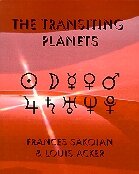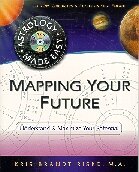July, 2011: The author, a noted astrologer in Barcelona, Spain, contacted me in March, 2011, asking if I would stock his newly translated book. I'm always happy to have books, but as I don't wholesale, distribution through me would be limited. So I referred him to the AFA, who were delighted to be of help. And now we have his book.
I have been in contact with Senor Estadella, of Barcelona, and a Mr. Isaac Starkman, of Tel Aviv, who have clarified various points. So let's begin.
This book is a sequel, of sorts, to Alexander Marr's Prediction, Using Common and Prenatal Cycles, of 1981. Like that book, use is made of Topocentric houses, primary directions, precessed solar returns (in this book termed Precessed Sidereal Solar Returns, which is a misnomer), various lunar returns (two principal, up to 14 in all), as well as progressions, both direct and converse, the prenatal chart, converse solar returns, which Estadella terms prenatal solar returns (confusing), converse - or prenatal - transits, as well as direct and converse progressions to precessed solar and lunar returns. (Converse returns and transits are as many years before your birth as your present age.) Notably missing are solar arc directions, which Mr. Starkman tells me do not really exist.
The key to using all of these methods is to have a properly rectified birth time. Your chart is not good enough just because your birth time was recorded to the minute. You need to have it accurate to +/-8 seconds. You do this by using Mr. Starkman's Polaris program, which has a weighted rectification routine. The usual questions, of significant births and deaths in your life, marriages, children, accidents, promotions, are each given a specific weight. This is an advance on other rectification programs, at least until they incorporate this feature (some may have already). The program is $350, it is, at this moment, only available from James Alexander, an American living in Germany. I ran this past Hank Friedman, who has been reviewing and selling astrological software for 30 years. He said he had heard of Polaris (and Astro, which will come up in a moment) but had never been able to get his hands on either. He suggested Regulus Platinum as a good alternative. It's $225.00. Estadella also mentions Astro, a DOS-based program written in the 1990's by Alexander Marr and available as a free download. (The link is to James Alexander's site.) Estadella says it's tricky to install. A Mr. Paul H emails to say one needs a Dos emulator, such as DosBox, in order to run it. I have not tried either program, software isn't my area of interest, but I have passed the links along to Hank. He says he will ask for a review copy. I've suggested to Estadella that if that request comes his way, he should grant it, as Friedman is a key player. I've also asked Friedman to keep me informed of his progress. As of this writing, neither program is available on Estadella's own website, but he tells me he will add Astro in the fall (of 2011).
So with all of that established, we turn to the book. Estadella limits himself to demostrating that his various methods will produce valid results. One of his examples is the investitute of Charles as Prince of Wales, on July 26, 1958, when he was nine years old. Estadella does not make a comprehensive survey of the event. He merely demonstrates the following five rather obscure aspects:
Direct progression of the direct precessed solar return:
- Progressed Jupiter sextile Mars, orb 7'
Converse progression of the direct precessed solar return:
- Progressed Moon sextile Venus, orb 2'
- Progressed Moon conjunct Pluto, orb 9'
Direct progressions of the prenatal precessed solar return:
- Progressed Mercury square the third house (Topocentric), orb 3'
Converse progressions of the prenatal precessed solar return:
- Progressed Mercury trine MC, orb 8' (pgs. 95-96)
As Starkman noted to me, there were many other aspects in orb on that day. Estadella is merely demonstrating technique.
As a sequel to Alexander Marr's book, Estadella's is not as well done. As something you need to do to enhance your forecasting abilities, my feelings are mixed. Most of us get along with much simplier techniques: Transits, progressions, solar arcs, solar returns, etc. I suggested to Estadella that if Polaris could take dates of events and from them produce rectified birth times, then if the resulting rectified time was entered back into that program, and with the same events as starting points, running the program backwards would produce a string of critical dates in the individual's life. It would be hugely demanding of the computer, but we can let the thing sit in a corner and run as many days as needed, and all we want is one year at a time anyway. This suggestion, so far, has been ignored.
In Marr's book is the regret that we cannot predict as accurately as Jean Baptiste Morin. Which I presume Estadella will echo, which I presume is/was the underlying reason for both books. That more detail, more complications, will provide the answer. This is quite puzzling, as Morin did not have birth times rectified to the nearest 8 seconds, nor did he have converse precessed solar returns to aid him. More detail is simply more detail. What is necessary are a sufficient number of proper details, which is another matter.
Morin made predictions based primarily on a close reading of the natal chart itself. Page 61 of Marr's book, a story that Morin predicted a "death on the scaffold", and for a particular woman, marriage to a king, not a commoner. Marr wonders how this is possible. It's quite simple: The man's natal chart had obnoxious things in and around his 4th (end of life) and 8th (time of death) houses. The woman's chart had Jupiter and or Mars configured to her 7th house. In England, Queen Elizabeth II has a Jupiter/Mars conjunction in her chart. (She has this even though, on the day of her birth, she was not in line to the throne at all, and was unlikely to ever be.) So does her son, Charles. In a royal chart, Jupiter/Mars denotes elevation to rule. William, son of Charles and grandson of Elizabeth, does not have Jupiter/Mars in his chart. He has Saturn/Mars instead. The outcome can already be predicted (court astrologers have presumably already done so), but I will spare you that. Note that these predictions, like those of Morin that Marr cites, do not have dates attached to them. That requires a different process. Marr has this in his very fingers, but fails to understand.
Overall, Marr's book is better written and better organized. Both he and Estadella are for those of you who want more detail. Lots and lots more detail.
Digital Star, 235 pages.


 Indicates a book on our Top Ten list. If you would like to find more books like it, click on the star.
Indicates a book on our Top Ten list. If you would like to find more books like it, click on the star.












